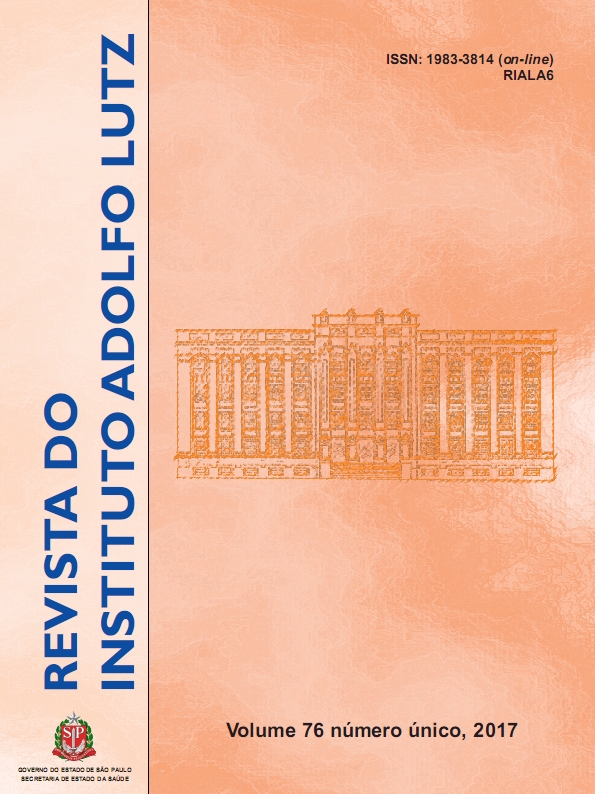Abstract
The objective of the study was to evaluate the hygienic-sanitary conditions in hospital nutrition services during of systematic intervention period based on requirements for personal and environmental hygiene. Fifteen hospital nutrition services were evaluated using a checklist and a microbiological analysis of the hands of food handlers and surfaces in contact with foods, before and after the intervention. The intervention was developed and conducted at the locations for one year by a third-party professional and included three stages: 1) application of checklist and action plan; 2) trainings; 3) monthly visits for motivation of handlers, supervisory technicians, and assistance and supervision in the implementation of the requirements regarding personal and environmental hygiene. The aerobic mesophilic microorganisms were studied as well as Staphylococcus aureus, total coliforms and thermotolerant coliforms. It was found that the personal hygiene and environmental conditions at the hospital nutrition services improved and there was decreased contamination of hands and surfaces after intervention. It was concluded that the systematic intervention by outside professional helped hygienic-sanitary conditions in hospital nutrition services meet the requirements and provide positive changes in the conduct of food handlers.References
1. Stangarlin L, Hecktheuer LH, Serafim AL, Medeiros LB. Evaluation of hygienic-sanitary conditions of hospital nutrition and dietary services from the perspectives of internal and external auditors. Food Sci Technol. 2013;33(3):521-5. [DOI: http://dx.doi.org/10.1590/S0101-20612013005000058].
2. World Health Organization. Improving nutrition outcomes with better water, sanitation and hygiene: practical solutions for policies and programmes. Geneva, Switzerland; 2015. Disponível em: [http://www.who.int/water_sanitation_health/publications/washandnutrition/en/]
3. Lund BM, O’Brien SJ. Microbiological safety of food in hospitals and other healthcare settings. J Hosp Infect. 2009;73(2):109-20. [DOI: http://dx.doi.org/10.016/j.jhin.2009.05.017].
4. World Health Organization. Five Keys to Safer Food Manual. Geneva, Switzerland; 2006. Disponível em: [http://www.who.int/foodsafety/publications/5keysmanual/en/].
5. Serafim AL, Hecktheuer LH, Stangarlin-Fiori L, Medeiros LB, Martello L, Machado CE. Evaluation of the implementation of good handling practices in food and beverage areas of hotels. J Food Prot. 2015;78(11):2043–51. [DOI: https://dx.doi.org/10.4315/0362-028X.JFP-15-144].
6. Brasil. Ministério da Saúde. Secretaria de Vigilância Sanitária. Resolução RDC nº 216, de 15 de setembro de 2004. Dispõe sobre Regulamento Técnico de Boas Práticas para Serviços de Alimentação. Diário Oficial [da] República Federativa do Brasil. Brasília, DF, 16 set. 2004. Seção 1, no 179. p25-8.
7. Rio Grande do Sul. Secretaria da Saúde. Portaria n° 78, de 30 de janeiro de 2009. Aprova a Lista de Verificação em Boas Práticas para Serviços de Alimentação, aprova Normas para Cursos de Capacitação em Boas Práticas para Serviços de Alimentação e dá outras providências. Diário Oficial [do] Estado do Rio Grande do Sul. Porto Alegre, RS, 30 jan. 2009. Disponível em: [http://www.tramandai.rs.gov.br/download/portaria_estadual_078_2009.pdf ].
8. Vanderzant C, Splittstoesser F. Compendium of Methods for the Microbiological Examination of Foods. 4th ed. Washington (DC): APHA; 2001.
9. Balzaretti CM, Marzano MA. Prevention of travel-related foodborne diseases: Microbiological risk assessment of food handlers and ready-to-eat foods in northern Italy airport restaurants. Food Control. 2013;29(1):202-7. [DOI: http://dx.doi.org/10.1016/j.foodcont.2012.05.077].
10. Henroid Jr DH, Mendonca AF, Sneed J. Microbiological evaluation of food contact surfaces in Iowa schools. Food Prot Trends. 2004;24(9):682-5.
11. Sneed J, Strohbehn C, Gilmore SA, Mendonca A. Microbiological evaluation of foodservice contact surfaces in Iowa assisted-living facilities. J Am Diet Assoc. 2004;104(11):1722–4. [DOI: http://dx.doi:10.1016/j.jada.2004.08.026].
12. Lambrechts AA, Human IS, Doughari JH, Lues JF. Bacterial contamination of the hands of food handlers as indicator of hand washing efficacy in some convenient food industries in South Africa. Pak J Med Sci. 2014;30(4):755–8.
13. Lopes LF, Müller I, Souza AM, Ansuj AP, Moraes DAO, Moreira Junior FJ et al. Cadernos didáticos: estatística geral. 3ª ed. Santa Maria (RS): CCNE; 2008, 209p.
14. Medeiros MG, Carvalho LR, Franco RM. Percepção sobre a higiene dos manipuladores de alimentos e perfil microbiológico em restaurante universitário. Ciênc Saúde Colet. 2017;22(2):383-92. [DOI: http://dx.doi.org/10.1590/1413-81232017222.17282015]

This work is licensed under a Creative Commons Attribution 4.0 International License.
Copyright (c) 2017 Instituto Adolfo Lutz Journal
